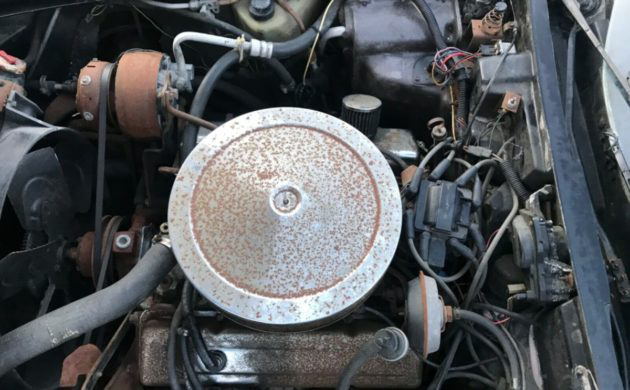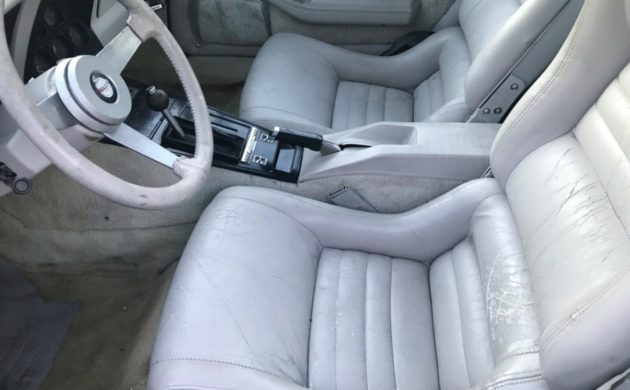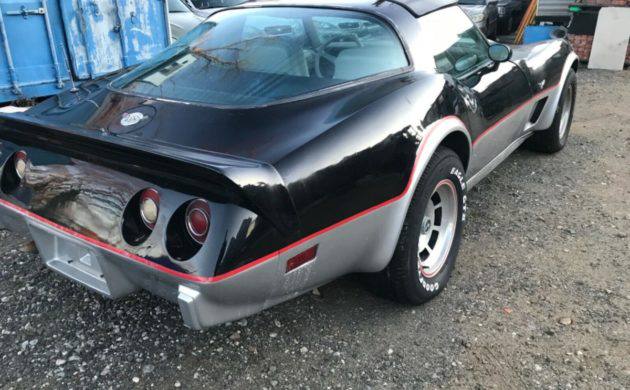Pace Car Project: 1978 Chevrolet Corvette Indy Pace Car
Chevrolet built 6,502 examples of the Corvette Indy Pace Car Edition, and we’ve managed to see quite a few of them here at Barn Finds. The vast majority of the examples that we’ve seen have tended to be vehicles that the owner has squirreled away soon after the initial purchase in the belief that they would represent a solid long-term investment. However, this particular Pace Car has not led a sheltered life. It has been driven and enjoyed, and it wears the scars to prove it. It will require some restoration work, but it could represent an affordable way for an enthusiast to get their hands on one of these cars. This one is located in Ozone Park, New York, and has been listed for sale here on eBay. The owner has set a BIN of $7,950 for the Corvette, and he makes it abundantly clear that this price is not negotiable.
To understand why some people bought vehicles like the Pace Car Edition and then hid them away in the belief that they would appreciate in value, I guess you really have to look at what was happening during that era in global motoring. Sadly, I’m old enough to have lived through a lot of this and experienced it first-hand. The Western World was still recovering from the Arab Oil Embargo and the severe shortage of oil and gasoline that resulted. Manufacturers, and the motoring public in general, were clamoring for smaller and more fuel-efficient vehicles. There were also irresistible forces that were pushing manufacturers to design and build engines that produced far fewer pollutants. One of the casualties of all of this pressure was the beloved V8 engine. Where a driver in the late 1960s could stamp on the gas pedal of their prized beast and be rewarded with copious amounts of power and acceleration, by the mid-1970s, the same action would produce noise…and not a lot else. These were the days before sophisticated electronic fuel injection and engine management systems. The days before composite technology and Computer-Aided Design and Manufacturing. The motoring press, and to a degree, the manufacturers, were sounding the death knell for the V8 engine. It was against this backdrop that people bought cars like this and squirreled them away. There was a real belief that cars like the Corvette, the Camaro, the Firebird, and cars of their ilk, were destined to go the way of the Dodo. With that belief in mind, what could be a better investment than a classic V8 that was kept preserved in “as-new” condition? Eventually, slow and painful development by manufacturers allowed these types of cars to remain in production until such point as all of those previously mentioned technologies could have their full impact, paving the way for some of the modern muscle cars that we see on our roads today. So, what seemed like a good idea at the time eventually turned out to be a less than flash long-term investments. Anyway, on to our feature car. This most definitely isn’t some cream-puff that has been hidden away in climate-controlled luxury. This is a car that has been driven and enjoyed. The owner believes that it might have received a repaint at some point in the past, but the number of scrapes and bumps that it currently wears suggests that another repaint will probably be right around the corner. The worst of the damage is on the front fender on the driver’s side. It looks like there might be some damage inflicted on the fiberglass itself, so that will need to be checked. There are plenty of other marks, chips, and scratches, so the best solution will be a full repaint. The owner provides a single, but no terribly good, photo of the vehicle’s underside, and it looks like there is little more than surface corrosion visible. I would like to know the state of the birdcage because when you see the corrosion that is present on some of the engine components, you have to believe that the Corvette has been exposed to moisture at some point in its life. The correct front and rear spoilers are still present, but it looks like the original mirror-tint roof panels have been replaced with painted ones. If this is the case then replacement panels with the correct finish are available, but they can cost around $600 a pair. The original wheels are also present, and while some of the center caps are missing, the wheels themselves look like they could present well with some hard work and a quality metal polish.
Potential buyers of a Pace Car could choose between the L48 and the L82 versions of the venerable 350ci V8. The L82 was the better pick, producing 220hp. This car comes equipped with the more common L48 version, so it has to make do with 185hp. Backing the 350 is a 3-speed automatic transmission, while power steering and power brakes were also part of the package. The owner makes no outrageous claims about this being a low-mileage example, and while the odometer is only showing 700 miles, he readily admits that it will have rolled-over at some point. The Corvette is said to run and drive okay, but it will need new tires and some attention to the brakes before it could be safely used as a daily driver. Those are the only problems that he identifies, which is potentially good news. When you look at the rust that is present on items such as the air cleaner, valve covers, and other components, you can see why I suggested checking to ensure that the birdcage is sound. There’s a lot more corrosion present there than I would normally expect to see.
When we dive inside the Corvette, what we find is an interior that is serviceable, but would not satisfy the more discerning buyer. On the plus side, the only non-original item (apart from the air freshener) is a Kenwood radio/cassette player that has replaced the original sound system. There are a few things that might need attention in the long-term to bring the interior back to its best, but there is nothing that is urgent. The leather on the seats, and in particular, the driver’s seat, is looking dry and cracked. This might respond to a good leather conditioner. However, I suspect that replacement will be a more viable option. These are quite easy to locate in the correct leather and color, and a pair of covers will generally sell for somewhere in the vicinity of $500. The glove compartment won’t remain closed, and this could be an issue with the lock or locking tab. Both items are cheap and easy to replace. The carpet is looking stained, and while it might clean okay, I would probably brace myself for replacement. There are also a number of small detail items that could be attended to if perfection is the goal, but I think that some serious cleaning would probably be a decent starting point with the Corvette. For comfort and convenience, the vehicle does come equipped with air conditioning, power windows, power locks, and a tilt/telescopic wheel.
Hindsight will always be 20:20 vision, and when we look at the 1978 Corvette Pace Car Edition today, it can be difficult to understand why so many people stored these away as future investments. Engine technology has come forward in leaps and bounds, and it isn’t hard to find a 4-cylinder production car that is capable of producing higher levels of both power and performance than this car would have in its prime. In 1978, this was something that was inconceivable, and I’m sure that few people expected that the V8 engine would not only remain in production, but would become so potent, well into the 21st century. All of these factors contrived to make those stored Pace Cars look like pretty bad investments because rather than appreciating in value, their values have actually dropped substantially in real terms. As a high-performance sports car, this one does miss its mark by a fair distance. As a car that is more about style over substance, then it is a winner. Today, you can buy a tidy Pace Car for around $22,000, but a really nice one with an L82 under the hood can sell for figures north of $35,000. If this car was fully restored, it could potentially reach that lower figure, and if the new owner is willing to do the basic disassembly, assembly, and the more mundane tasks themselves, it could achieve this goal while remaining well and truly financially viable. If the new owner isn’t fixated on originality, they could splash some extra cash on some mechanical upgrades, blessing this car with the sort of performance that would befit a true Indy Pace Car. What would you do?
Auctions Ending Soon
 2002 Subaru Impreza WRXBid Now11 hours$333
2002 Subaru Impreza WRXBid Now11 hours$333
 1975 Chevrolet Corvette ConvertibleBid Now12 hours$4,000
1975 Chevrolet Corvette ConvertibleBid Now12 hours$4,000
 1964 Ford F-100 Camper CustomBid Now13 hours$2,000
1964 Ford F-100 Camper CustomBid Now13 hours$2,000
 2006 Jeep Wrangler SportBid Now2 days$11,000
2006 Jeep Wrangler SportBid Now2 days$11,000
 1974 Datsun 260ZBid Now4 days$750
1974 Datsun 260ZBid Now4 days$750






Comments
Wonder who they paid off to get to call that an “Indy Pace Car”?
It couldn’t pace the Kentucky Derby.
Another Corvette ridden hard and put away wet. Used up and ready to be kicked aside. Assuming the bird cage is OK,(doubtful) I wouldn’t waste my time saving this powertrain. LS manual it and clean up the interior. These are not special enough for saving.
Junk new. Junk now. Not rare. All hype.
Those wheels would look great on my ’75.
Friend of mine with money thought those were gonna be rare and they said only 1 per dealer would be made! People paid good money to get the only one in there town and went to the highest bidder. My friend bought his and paid 50,000 for it, they kept making them and didn’t do what they said and price came way down and he got ticked off and parked it in edge of a corn field for everyone to see! Had 52 miles on it when he did that! It sat there quite awhile and everyone tried to get it before mice ruined it, he told every one this is a Gm blunder and it can sit there and rot to the ground! Don’t ask about it because its not for sale. Couple years it had been ate up by field mice on wiring and interior, air cleaner, but looked good sitting there! Was still there when I left town in 1984. This car reminds me of that! They can be fixed up and always liked color combo, corvettes in those years were gutless, so best thing you could do is bore it 30 over and make a nice 355 with good heads or alumium if you wanted a nice driver! If kept stock appearing it wouldn’t alter value! So with corvettes under the hood and interior, black out frame and front suspension and your all set!! Nothing on body to rust, You want that look buy a 78 ,paint it that way, put spoliers on and door decals and wheels, all available to buy, most I seen had that Silvery interior! We made one a for a guy in 1980. Not hard to do and at one time on a used car lot in Florida we had 3 originals for sale at once and 4 of the 1982s with finned wheels and pop up rear window! People were getting rid of them. We eventually sold them around 1985 for bottom pricing! -Nothing special about them! Did like the way the 1982 sit and rode and the pop up rear window was different! Don’t look like the value of these have changed much over the years !
Something about the front spoiler doesn’t look right.
Way too gaudy for my tastes. I seriously would not drive it around the block in the middle of a starless night!
In that interior shot the color looks to be the wrong color. Didn’t the Pace cars come with a silver interior. Maybe it’s just the lighting that makes look white or oyster I think it was.
That non stock front spoiler could be of some cooling benefit.
Unless the hood was left open outside, could only a FLOOD explain rust on chrome, pulleys & a/c compressor?
Everything on it is the way they came spoliers wise! But that oyster white interior so it could be a look alike unless someone changed out the moon silver interior! And yes southern cars get cooked by the sun in 5 years and exposed to floods from hurricanes with salt water! Who knows, it’s been exposed to moisture for sure, like something hit the left front fender from damage on it and center cap missing! Like a hurricane surge! Insurance buys them up and puts cars ect. In a compound to be auctioned off,! Lots of floods down there and around in last couple years! I would want to really check this up under dash ,electrical, and around before paying that kind of money and run Vin #s for originally.